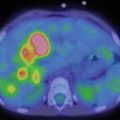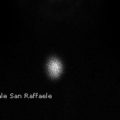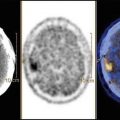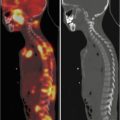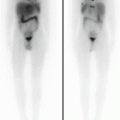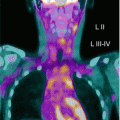No prior exposure to XRT
Prior exposure to XRT
Reason for referral
Reason for referral
Suspicion of thyroid tumor
Other
All
Suspicion of thyroid tumor
Other
All
Number of patients at risk
11,015
24,010
35,025
608
1159
1767
Observed number of thyroid cancers
69
36
105
12
12
24
Percentage male
14
23
20
18
25
22
Mean age at first exposure (range, years)
44 (0–74)
43 (0–74)
43 (0–74)
53 (16–74)
51 (8–74)
52 (8–74)
Patients <20 years of age at exposure (%)
6
7
7
0
2
1
Mean follow-up period (range, years)
27 (2–47)
27 (2–47)
27 (2–47)
20 (2–44)
20 (2–47)
20 (2–47)
Mean number of administered doses (range)
1.3 (1–10)
1.3 (1–9)
1.3 (1–10)
–
–
–
Mean total administered activity (MBq)
2.5
1.6
1.9
3.5
3.1
3.2
Mean 24 h thyroid uptake (%)
39
38
39
36
36
36
Mean total absorbed I-131 dose to thyroid (Gy)
1.37
0.94
1.07
1.75
1.74
1.74
The authors did not find any evidence of an excess cancer risk for patients who were referred for a reason other than suspicion of a thyroid tumor and did not report external radiation therapy [7]. However, for the patient group suspicious for thyroid tumor, an excess risk was found.
For the group with previous external radiation therapy, both subgroups showed an excess cancer risk, which was higher for the group with suspicious thyroid tumor.
Nevertheless, both factors – suspicion for thyroid cancer and external radiation therapy of the head and neck – were confounding factors.
The authors did not find a dose-response relationship or variation in risk with age, but it has to be mentioned that the cohort included only 7 % patients under the age of 20, so this is only a vague conclusion.
It is known [1, 13] that children are much more sensitive to radiation exposure than adults. Compared to the adult thyroid gland, the thyroid gland of children proliferates more rapidly and it is therefore believed that the fast growth of the radiation-injured cells is the reason for the apparent effects in children. Furthermore, children have more years of cancer risk, because of their longer life expectancy.
A German multicenter retrospective cohort study investigating diagnostic administration of I-131 in children, with a median thyroid dose of 1 Gy, has not found any significantly increased risk of thyroid cancer in children [11]. A detailed characterization of the absorbed doses with age and initial diagnoses can be found in Table 4.2. However, in this study, the number of patients studied (789 exposed subjects and 1118 nonexposed subjects) and the follow-up time were limited and furthermore, only a very small number of children under the age of 5 were part of the study. For this age group, the highest thyroid cancer rate was found in the most heavily contaminated areas after the Chernobyl accident [11].
Initial diagnosis | n = 789 | Median thyroid dose, Gy (interquartile range) |
|---|---|---|
Missing values | 10 | 1.6 (0.8–1.9) |
Uncertain diagnosis | 13 | 1.5 (1.0–2.2) |
Hyperthyroidism | 34 | 1.5 (0.9–2.6) |
Hypothyroidism | 61 | 0.3 (0.2–0.7) |
Goiter | 385 | 1.1 (0.7–1.6) |
Nodular goiter | 77 | 1.0 (0.7–1.7) |
Iodine metabolism disorder | 10 | 1.8 (1.0–3.5) |
No evidence of disease | 199 | 0.8 (0.5–1.4) |
Age at first administration | ||
0–5 years | 62 | 0.6 (0.2–1.7) |
6–10 years | 85 | 0.8 (0.5–1.4) |
11–15 years | 366 | 1.2 (0.6–1.7) |
16–17 years | 276 | 1.0 (0.6–1.4) |
All | 789 | 1.0 (0.5–1.6) |
According to these studies, there is no evidence that diagnostic exposure of I-131 causes excessive thyroid cancer cases [7, 11, 12, 15, 31].
4.3.2 Thyroid Cancer Caused by Radiation Exposure of the Japanese Atomic Bomb and the Chernobyl Accident
Cardis et al. [5] emphasized in their article about “Risk of thyroid cancer after exposure to I-131 in childhood” that the iodine deficiency and the iodine supplementation appear to be important and independent modifiers of the thyroid cancer risk after exposure of I-131 in childhood [5]. The authors carried out a case-control study of thyroid cancer in children younger than 15 years in 1986 and who lived in Belarus and the Russian Federation, taking account of environmental and host factors. They found that the relative risk of thyroid cancer in exposed children in iodine deficiency areas is three times higher than elsewhere and that an iodine supplemental diet (taken after exposure and even months after) reduced the relative risk by a factor of three.
Richardson [25] analyzed the cancer incidences among the atomic bomb survivors of Hiroshima and Nagasaki who were 20 years and older at the time of the bombing. He used Poisson regression methods for data analyzing and deriving associations between thyroid absorbed dose and thyroid cancer incidence by sex, age at exposure, and time-since-exposure [25].
In most reviews [2, 28], people conclude that there is only little evidence of radiation-induced thyroid cancer in adult atomic bomb survivors. Richardson concludes in his article that there is evidence of an increased thyroid cancer rate among female A-bomb survivors as compared to male survivors. Nevertheless, these studies of atomic bomb survivors do not provide information on internal intake of radioactive iodine [2].
Stay updated, free articles. Join our Telegram channel

Full access? Get Clinical Tree


